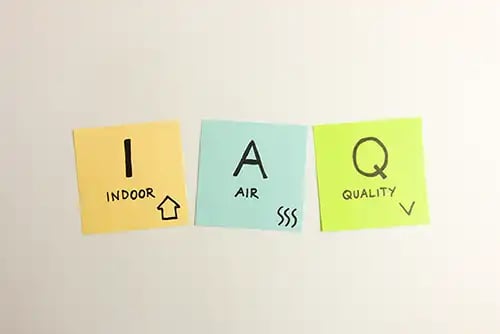
VOCs, or Volatile Organic Compounds, are chemicals that can easily evaporate into the air at room temperature. In textiles, VOCs can be found in various forms, such as solvents, dyes, and finishes used in manufacturing. These compounds can be emitted into the air and may contribute to indoor air pollution, adversely affecting human health and the environment.
VOCs can be found in many products, including paints, varnishes, cleaning supplies, and textiles. In textiles, VOCs can come from the dyes and chemicals used to color and finish fabrics. These compounds can be released into the air over time, a process known as off-gassing.
Volatile Organic Compounds (VOCs) can quickly evaporate into the air at room temperature. They are found in various products and materials, including paints, cleaning supplies, pesticides, building materials, and household products. While not all VOCs are harmful, some can pose significant health risks. Here are some of the dangers associated with VOC exposure:
- Health Effects: Short-term exposure to high levels of VOCs can cause eye, nose, and throat irritation, headaches, dizziness, and nausea. Long-term exposure to lower levels of VOCs may lead to more severe health problems, including liver, kidney, and central nervous system damage.
- Respiratory Problems: VOCs can exacerbate symptoms in individuals with respiratory conditions such as asthma. Prolonged exposure to VOCs can lead to the development of respiratory issues in otherwise healthy individuals as well.
- Indoor Air Quality: VOCs can contribute to poor indoor air quality, which can lead to a range of health problems, including respiratory diseases, allergies, and fatigue.
- Environmental Impact: VOCs contribute to the formation of ground-level ozone and smog, which can harm the environment and human health. They also contribute to air pollution and can harm plants, animals, and ecosystems.
- Cancer Risk: Some VOCs, such as formaldehyde and benzene, are classified as carcinogens and have been linked to increased cancer risk after long-term exposure.
- Off-Gassing: Many household products release VOCs through off-gassing. This occurs when products like furniture, carpets, and mattresses release VOCs into the air over time, leading to prolonged exposure in indoor environments.
- Sick Building Syndrome: Buildings with high levels of VOCs can contribute to sick building syndrome, where occupants experience various health issues without a specific identifiable cause.
To mitigate the impact of VOCs in textiles, manufacturers may use environmentally friendly and low-VOC or VOC-free dyes and finishes. Additionally, proper ventilation and airing out newly purchased fabrics can help reduce the concentration of VOCs in indoor environments.
To reduce the risks associated with VOC exposure, it's essential to choose products with low or no VOC content, ensure proper ventilation in indoor spaces, and use household products in well-ventilated areas or wear protective equipment such as masks and gloves when using them. Regular air quality testing can also help identify and mitigate VOC levels in indoor environments.
Several certifications and standards exist to assess and ensure indoor air quality. Here are some notable ones:
- LEED (Leadership in Energy and Environmental Design): LEED certification, provided by the U.S. Green Building Council, evaluates buildings for their overall environmental performance. This certification includes criteria related to indoor air quality, encouraging the use of low-emitting materials, and proper ventilation systems.
- GREENGUARD Certification: GREENGUARD certification, offered by UL Environment, focuses on low-emission products and materials, including those used in indoor spaces. It ensures that products have low chemical emissions, contributing to healthier indoor air.
- FloorScore Certification: FloorScore certification is specific to flooring materials. It verifies that flooring products meet low-emission standards and are safe for indoor air quality. It is often used for flooring products like carpets, vinyl, laminate, and hardwood.
- FSC (Forest Stewardship Council): While not solely an indoor air quality certification, FSC certifies wood and wood-based products sourced from responsibly managed forests. Using FSC-certified wood can improve indoor air quality by reducing harmful chemicals in wooden materials.
- Cradle-to-Cradle Certification: Cradle-to-Cradle certification evaluates products based on their environmental impact and encourages the use of safe and sustainable materials. This certification covers various aspects, including indoor air quality considerations.
- BREEAM (Building Research Establishment Environmental Assessment Method): BREEAM is a widely used environmental assessment method for buildings. It evaluates facilities based on various criteria, including indoor air quality and the use of low-emission materials.
- WELL Building Standard: The WELL Building Standard focuses specifically on the health and well-being of building occupants. It includes criteria related to air quality, ventilation, and the use of low-emitting materials to promote a healthier indoor environment.
When looking for products or buildings that promote good indoor air quality, checking for these certifications can ensure that they meet specific standards related to low emissions and overall environmental impact. Different countries and regions may have certifications and bars, so knowing the certifications relevant to your location is essential.
Herculite is proud to have three of its high-performance flexible composites achieve GREENGUARD Gold Certification. The entire assortment of Weather-Chek® awning fabrics, Sure-Chek Linen® healthcare curtain fabrics, and the Architent® Starfree Blackout tent fabrics have completed the rigorous process to achieve this certification. Learn more here.